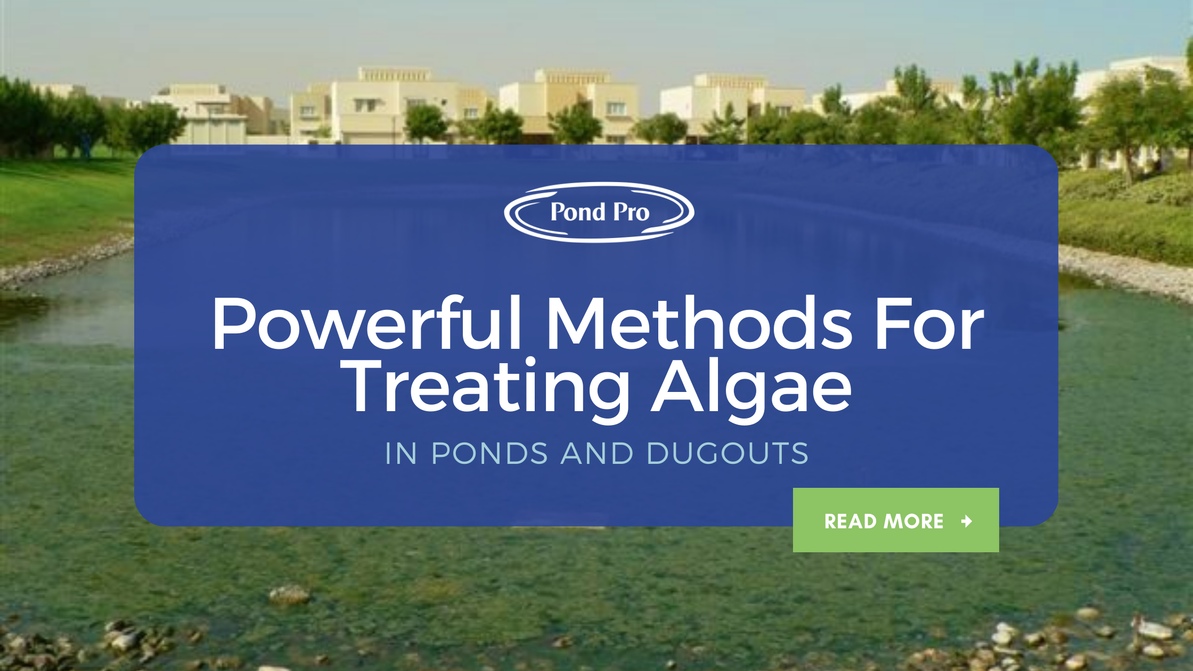Powerful Methods for Treating Algae in Ponds and Dugouts
Pond & Dugout Algae Treatment
There are two main types of algae and they both must be treated very differently if they are already present. They both are treated with ProClear Algaecide. This product works by being absorbed by the algae which then kills it. However, while both types are treated with ProClear, thy are treated with different rates and different methods.

Filamentous algae is non-toxic, but is a cosmetic inconvenience that decreases water quality. It creates a thick sludge, almost like a film.
It is the easiest to treat as it requires shoreline treatment. We recommend filamentous algae be treated at a rate of 1L of ProClear algaecide for every 50-100 feet of shoreline. Keep in mind that the thicker the algae is, the more product it will need. If it is very thick, treat 1L/50feet. If algae is thin or if you are treating proactively, 1L per 100ft is adequate.
This treatment should be followed up with NaturalClear Pond Bacteria Treatment. See below for additional info.
Warning for treating algae in fish ponds: When algae dies it depletes oxygen levels in the pond. Killing a large amount of algae (particularly blue-green algae) in a pond will deplete oxygen to levels where fish can not survive!
To prevent fish kill: If algae is thick, it must be treated 1/3rd of the pond at a time to prevent a drastic oxygen depletion and resulting fish kill. Aeration should be turned off for 2 hours at time of treatment. After these 2 hours, aeration should run 24/7 for next week or until next treatment. This treatment can be repeated weekly until entire pond is treated. It may need to be repeated once to ensure all blue-green algae is treated.
Do not exceed 3L per 1 million gallons in a pond that has fish present

Blue-Green Algae is a serious health concern. It releases toxins that are dangerous to humans and livestock and can deplete oxygen enough to prompt a fish kill, even if the pond has aeration.
This algae can appear as a thick film sludge (like the photo above) or as small short growths, often described as looking like grass clippings.
This species of algae is actually not an algae at all, but rather a bacteria. It spreads quickly and can take over entire ponds in a short amount of time. This species is so concerning because it releases toxins strong enough to kill a dog in 30 minutes. This algae needs to be hit hard from the time the first bloom is visible.
Blue-Green algae can typically be treated at a rate of 3L of ProClear for every 4 million L of water. This treatment should be followed up with All-Natural Pond Clarifier to reduce and remove the dead algae from the pond.
However, blue-green algae must be treated with caution due to the toxins that can be released. Contact our experts at 1-855-414-7663 or sales@pondpro.ca for professional advice.
Warning for treating algae in fish ponds: When algae dies it depletes oxygen levels in the pond. Killing a large amount of algae (particularly blue-green algae) in a pond will deplete oxygen to levels where fish can not survive!
To prevent fish kill: If algae is thick, it must be treated 1/3rd of the pond at a time to prevent a drastic oxygen depletion and resulting fish kill. Aeration should be turned off for 2 hours at time of treatment. After these 2 hours, aeration should run 24/7 for next week or until next treatment. This treatment can be repeated weekly until entire pond is treated. It may need to be repeated once to ensure all blue-green algae is treated.
Do not exceed 3L per 1 million gallons in a pond that has fish present
ProClear Algaecide & the Need for Bacteria Treatment
After the algae dies post treatment, it sinks to the bottom of the pond. If the pond is not treated with NaturalClear Pond Bacteria Treatment the dead algae simply starts decaying into sludge and muck, creating a thick sludge layer on the pond bottom and making the water murky and foul-smelling.
This can easily be prevented with a follow-up treatment of good bacteria – a probiotic for your pond! Pond Pro All-Natural Clarifier is a healthy bacteria for your pond that works in multiple ways to clear the pond water.
- It first eats away at dead vegetation, sludge and other organics, removing it from the pond as gases
- It also locks up phosphates and other nutrients that algae and other unwanted vegetation lives off of
Algae is a common issue that can be treated! Once algae is treated and under control, it can be mainly prevented with ongoing water quality maintenance plans. Contact our experts at 1-855-414-7663 or sales@pondpro.ca for an no-obligation Free Algae Prevention & Pond Maintenance Plan.
Turn Tips into Action – Shop this Blog Post!
Recent Posts
-
Top Gift Ideas for Pond Owners: Practical, Fun & Perfect for Any Season
With the holiday season quickly approaching, it’s the perfect time to start thinking about meaningfu …4th Dec 2025 -
De-Icing System Sizing Guide: How to Pick the Right System for Your Pond or Dock
Learn how to size, install, and position a pond or dock de-icer for cold climates. Protect your fish …28th Nov 2025 -
Winter Survival Guide for Pond Fish
Winter Survival Guide for Pond Fish How to keep your fish healthy, oxygenated, and stress-free all w …18th Nov 2025




